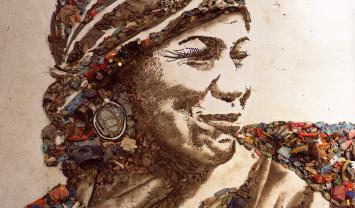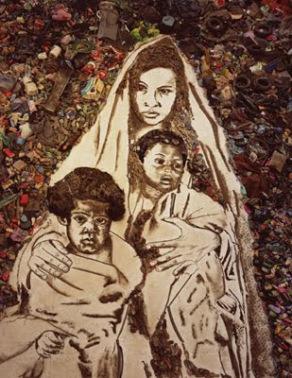The conclusion to a proposed musical theater piece about the award-winning documentary ‘Waste Land’ (‘Lixo Extraordinário’)
 Artist Vik Muniz
Artist Vik Muniz
In the first part of my tribute to the denizens of the Jardim Gramacho slum (see the following link: http://josmarlopes.wordpress.com/2014/06/13/waste-land-the-musical-we-suffer-we-die-and-were-buried/), one of the catadores was hurt by an unfriendly encounter with a garbage truck and its contents. Meanwhile, the office was looted by drug thieves who made off with the monthly payroll.
Act II: Resolution
Number 12. “Rescue Attempt” – The garbage pickers pull Zumbie out from under the crumbling rubbish heap. “The truck’s gate fell on him,” yells Big Carl, one of the slum’s inhabitants, “but he’s going to be okay.” With a huge sigh of relief, the garbage pickers take the stricken catador de lixo to the hospital. “Over 20 people will donate blood,” Zumbie announces proudly. “I’m surrounded by good fr-fr-friends.” He’s well on his way toward mending, both physically and emotionally.
Number 13. “Vik’s Visit” – The famous artist, Vik Muniz, now comes to call on Jardim Gramacho with a unique proposal for the pickers. He wants to take their pictures – i.e., photographs of the workers, in all sorts of weird poses. As Vik explains it, he intends to recreate the classic paintings of old. The garbage pickers look at him in alarm and amazement. “What’s this all about?” they wonder openly.
Vik tries to clarify his idea, but they still don’t get it. “Pictures? Pictures of what?” they inquire in unison. “Pictures of garbage,” Vik replies, rather matter-of-factly. They are even more astonished at this alleged clarification. They still can’t believe their ears. “Who in their right mind would want to do that?” they declare. “I would,” says Vik. “It’s what I do for a living.” “And people say we’re crazy!” is their response. This leads to an extended discussion (via an ensemble passage) where everyone chimes in with their own ideas about the project.
Eventually, the issues are resolved and the garbage pickers’ reluctance begins to fade. Vik is making headway in his appeals to their self-esteem: he wants them to think of his project as a possible “way out” from the dead-end lives they’ve been leading.
Number 14. “Death of Marat” – The first to take his turn at the canvas is boss-man Tião, who decides to pose for the painting of Jacques-Louis David’s “Death of Marat,” followed cautiously by the other participants. In a humorous episode, Tião starts to undress before the other participants, who shyly look away as he slips into Marat’s outfit. “Irmã’s Painting” is next in line. After posing for her picture, she is finally able to see herself as others do. “Artists have to suffer,” she offers, which leads into the next number.

Number 15. “Isis’ Suffering” – “They aren’t the only ones,” cries Isis, another of Jardim Gramacho’s put-upon residents. “I don’t see myself in this trash heap anymore. I don’t want to go back to the garbage. I don’t…” Isis then reminisces about her young son, who died in a nearby hospital of pneumonia. The scene shifts between her recollection of the recent past and the events at the landfill, which are taking place simultaneously – in parallel – but on two different levels. Some of the garbage pickers are transformed into doctors and nurses, keeping Isis informed of her son’s deteriorating condition.
This becomes the emotional crux of the drama, wherein Isis sings about the ant crawling on her deceased son’s face – the same ant that, if one pulls back far enough away from the landfill, everyone appears to resemble. “We’re just a bunch of tiny insects in this life,” Isis insists. “I saw my son die at three years old,” as she resumes her story. “He died of acute pneumonia. His name was Carlos Igor.” At the mention of his name, Isis breaks down in tears. In trying to comfort her, Vik tells her that no one can do anything more to her than has already been done. His mission, then, is to help the populace see what life is like on the outside, beyond the confines of the garbage dump. That is the most that he can do – the rest is up to them!
Number 16. “Lesson: How to Look at Art” – This is the scene where Vik instructs the residents of Jardim Gramacho how people who go to museums look at (and appreciate) the works of art they find there. First, they take a step up to the painting, and then they take a step back. This routine turns into an amusing vignette, with the onlookers contributing their own versions of “how to look at art.”
In the meantime, the lesson continues: back and forth, everybody leans in and everybody leans out; they move away, see the material, see the landscape, and then move out again. “Since we’re all garbage pickers,” they claim, “all we see are the recyclable materials.” “But that’s the thing,” Vik pipes in. “They’ll spend hours looking at your photographs. There is more to them than just garbage. Watch, you’ll see.” We know exactly what he means, which is: there’s more to the garbage pickers – much more, it turns out – than meets the eye. You just have to “get up close and personal” to simple folk, they retort, to learn “who we really are” – just like regular folk do with the paintings.

Number 17. “Madonna and Child” – A photo session involving Suelem and her two children takes place. In recreating the artwork, the garbage pickers themselves do the actual placing of the objects onto the photo – that is, they recreate the art from the trash heaps that they themselves have picked. In addition, each work is a commentary – a personal statement, if you will – on the personality and character of the individual who did the picking. For the “Madonna and Child,” this indeed is how Suelem sees herself and her brood.
This happens to be the real theme of the show: i.e., how others have perceived the garbage pickers to be, but, most importantly of all, how Vik, the artist, and especially the garbage pickers, see themselves and their roles in life. It goes beyond what anyone ever imagined at the start. How much they have changed in such a short time! Each finished photo is displayed in its glory. The garbage pickers are overcome with emotion by their wonderful portraits, especially Big Carl and his wife.
Number 18. “The Museum Visit” – In a change of scenery, reporters appear to gather around the garbage pickers doing makeshift interviews. At the museum, Vik and Tião stumble upon a bronze sculpture of a garbage bag. “What’s in it?” Vik asks. “Can you tell me? Can you venture a guess?” Tião pauses and ponders the contents. “Hmm, a cup of yogurt, hearts of palm, small boxes, a brand new cell phone, and the rest.” This scene is reflective of an earlier one, in Act I, in which the pickers made fun of people’s trash. It ends with Tião’s perceptive comment: “I feel like a pop star.”
We next revisit the skit, “How to Look at Art,” now called “Life Imitates Art,” but this time it is put into practice, with the garbage pickers seeing real people looking at their precious pieces of art, in exactly the way that Vik had taught them beforehand, the living embodiment of the phrase “life imitates art.” Both garbage pickers and museum visitors admire each other, first from afar and then from close up, a rather comical observation on how different groups of individuals behave and perceive the other to be – and a perfect illustration of the point that Vik Muniz was trying to make above.
Number 19. “The Auction” – It starts with the sale of an Andy Warhol original, beginning almost in staccato form, à la Mrs. Lovett from Sondheim’s Sweeney Todd. Interspersed with the auctioneer pointing to various parties gathered at the auction, there are comments and asides from Vik and Tião interspersed throughout, as well as from the other participants, somewhat along the lines of: “Did you hear? Did you hear?” and “Did he say twenty, did he say twenty?” “Is it true? Is it true?” “It’s been sold for fifty thousand and two! Did he say fifty, did he say fifty? Sold today, sold today? Is it true what they say?”
At scene’s end, Tião’s picture is sold for $50,000 dollars. He is overcome with emotion and breaks down, weeping with joy – quite a different situation from the earlier one at the end of the first act, where we found him bawling his eyes out at the loss of the company payroll. He simply can’t believe his good fortune. “It’s all worth it. It really is,” he admits. Vik and Tião embrace warmly, in friendship and solidarity, as the onlookers break out into spontaneous applause.

Number 20. “Finale” – The musical ends with Tião and the garbage pickers’ appearance on a popular TV talk show (in Rio de Janeiro, it’s Jo Soares’ program; in America, it’s Jimmy Fallon, Seth Meyers or Stephen Colbert). Here, the talk-show host introduces the group as “collectors of garbage.” Tião has the polite audacity to confront him: “If I may correct you, sir. Garbage can’t be reused, whereas recyclable materials can. We are not pickers of garbage, but pickers of recyclable material.” What he’s trying to say is that human life is never wasted; it’s always salvageable – recyclable, if you prefer – even if you’re a lowly garbage picker. “I stand corrected,” Soares states, as he looks out approvingly into the audience.
The show comes to a rousing close with the repeat of Valter’s number, “Here’s wisdom aplenty: Ninety-nine is not a hundred, and nineteen is not twenty,” after the elder statesman’s personal motto. The entire cast comes out in a stirring rendition of “The Waste Land Song”:
Seven thousand tons of trash
Work all day for little cash
Robbing Peter, paying Paul
Look, here comes another haul
It’s a Waste Land
The set reverts back one last time to the garbage dump overlooking Guanabara Bay. Only this time, Christ the Redeemer is facing the audience. His massive stone countenance is seen looking down on the inhabitants. It almost appears as if He’s given His blessing to the goings on.
Blackout and curtain
Copyright © 2014 by Josmar F. Lopes

